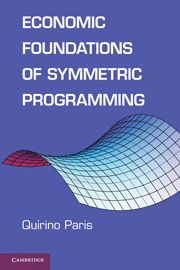Book contents
- Frontmatter
- Contents
- Foreword
- Preface
- 1 Introduction
- 2 Lagrangean Theory
- 3 Karush-Kuhn-Tucker Theory
- 4 Solving Systems of Linear Equations
- 5 Asymmetric and Symmetric Quadratic Programming
- 6 Linear Complementarity Problem
- 7 The Price Taker
- 8 The Monopolist
- 9 The Monopsonist
- 10 Risk Programming
- 11 Comparative Statics and Parametric Programming
- 12 General Market Equilibrium
- 13 Two-Person Zero- and Non-Zero-Sum Games
- 14 Positive Mathematical Programming
- 15 Multiple Optimal Solutions
- 16 Lemke Complementary Pivot Algorithm User Manual
- 17 Lemke Fortran 77 Program
- Index
13 - Two-Person Zero- and Non-Zero-Sum Games
Published online by Cambridge University Press: 05 June 2012
- Frontmatter
- Contents
- Foreword
- Preface
- 1 Introduction
- 2 Lagrangean Theory
- 3 Karush-Kuhn-Tucker Theory
- 4 Solving Systems of Linear Equations
- 5 Asymmetric and Symmetric Quadratic Programming
- 6 Linear Complementarity Problem
- 7 The Price Taker
- 8 The Monopolist
- 9 The Monopsonist
- 10 Risk Programming
- 11 Comparative Statics and Parametric Programming
- 12 General Market Equilibrium
- 13 Two-Person Zero- and Non-Zero-Sum Games
- 14 Positive Mathematical Programming
- 15 Multiple Optimal Solutions
- 16 Lemke Complementary Pivot Algorithm User Manual
- 17 Lemke Fortran 77 Program
- Index
Summary
Game theory deals with conflicts of interest between (among) persons. A game is a situation of conflict in which two or more persons interact by choosing an admissible set of actions while knowing the reward associated with each action. The persons who interact are called players, the set of actions are called strategies, and the rewards are called payoffs. Hence, a game is a set of rules describing all the possible actions available to each player in correspondence with the associated payoff. In a game, it is assumed that each player will attempt to optimize his/her (expected) payoff.
In this chapter, we discuss two categories of games that involve two players, player 1 and player 2. The first category includes zero-sum games, in which the total payoff awarded the two players is equal to zero. In other words, the “gain” of one player is equal to the “loss” of the other player. This type of games assumes the structure of a dual pair of linear programming problems. The second category includes games for which the total payoff is not equal to zero and each player may have a positive payoff. This type of games requires the structure of a linear complementarity problem in what is called a bimatrix game.
The notion of strategy is fundamental in game theory. A strategy is the specification of all possible actions that a player can take for each move of the other player.
- Type
- Chapter
- Information
- Economic Foundations of Symmetric Programming , pp. 318 - 339Publisher: Cambridge University PressPrint publication year: 2010



